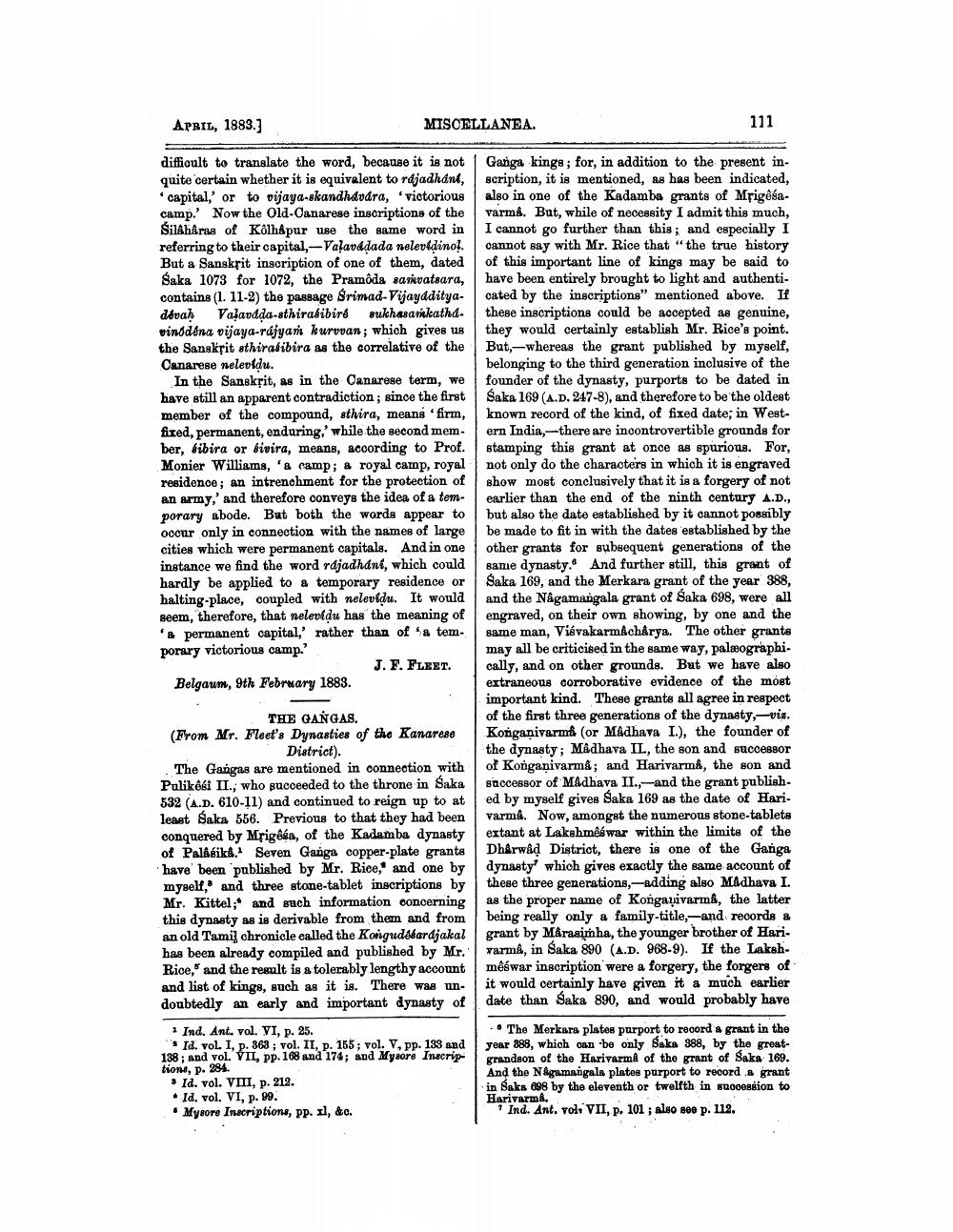________________
APRIL, 1883.]
difficult to translate the word, because it is not quite certain whether it is equivalent to rajadhání, 'capital,' or to vijaya-skandhávára, 'victorious camp.' Now the Old-Canarese inscriptions of the Šilâhâras of Kolhapur use the same word in referring to their capital,-Valaváḍada neleviḍinol. But a Sanskrit inscription of one of them, dated Saka 1073 for 1072, the Pramôda samvatsara, contains (1. 11-2) the passage Srimad-VijayadityaValavdda-sthirasibiré sukhasamkatha. vinodéna vijaya-rajyam kurvvan; which gives us the Sanskrit sthirasibira as the correlative of the Canarese neleviḍu.
dévaḥ
In the Sanskrit, as in the Canarese term, we have still an apparent contradiction; since the first member of the compound, sthira, means 'firm, fixed, permanent, enduring,' while the second member, sibira or bivira, means, according to Prof. Monier Williams, a camp; a royal camp, royal residence; an intrenchment for the protection of an army,' and therefore conveys the idea of a temporary abode. But both the words appear to occur only in connection with the names of large cities which were permanent capitals. And in one instance we find the word rdjadhání, which could hardly be applied to a temporary residence or halting-place, coupled with nelevidu. It would seem, therefore, that neleviḍu has the meaning of 'a permanent capital,' rather than of a temporary victorious camp.'
J. F. FLEET.
Belgaum, 9th February 1883.
THE GANGAS.
(From Mr. Fleet's Dynasties of the Kanarese District).
The Gangas are mentioned in connection with Pulikési II., who succeeded to the throne in Śaka 532 (A.D. 610-11) and continued to reign up to at least Saka 556. Previous to that they had been conquered by Mrigêéa, of the Kadamba dynasty of Palasiks. Seven Ganga copper-plate grants have been published by Mr. Rice, and one by myself, and three stone-tablet inscriptions by Mr. Kittel; and such information eoncerning this dynasty as is derivable from them and from an old Tamil chronicle called the Kongudééardjakal has been already compiled and published by Mr. Rice, and the result is a tolerably lengthy account and list of kings, such as it is. There was undoubtedly an early and important dynasty of
MISCELLANEA.
1 Ind. Ant. vol. VI, p. 25.
Id. vol. I, p. 363; vol. II, p. 155; vol. V, pp. 133 and 138; and vol. VII, pp. 168 and 174; and Mysore Inscriptions, p. 284.
Id. vol. VIII, p. 212.
Id. vol. VI, p. 99.
Mysore Inscriptions, pp. xl, &c.
111
Ganga kings; for, in addition to the present inscription, it is mentioned, as has been indicated, also in one of the Kadamba grants of Mrigesavarma. But, while of necessity I admit this much, I cannot go further than this; and especially I cannot say with Mr. Rice that "the true history of this important line of kings may be said to have been entirely brought to light and authenticated by the inscriptions" mentioned above. If these inscriptions could be accepted as genuine, they would certainly establish Mr. Rice's point. But, whereas the grant published by myself, belonging to the third generation inclusive of the founder of the dynasty, purports to be dated in Saka 169 (A.D. 247-8), and therefore to be the oldest known record of the kind, of fixed date; in Western India, there are incontrovertible grounds for stamping this grant at once as spurious. For, not only do the characters in which it is engraved show most conclusively that it is a forgery of not earlier than the end of the ninth century A.D., but also the date established by it cannot possibly be made to fit in with the dates established by the other grants for subsequent generations of the same dynasty. And further still, this grant of Saka 169, and the Merkara grant of the year 388, and the Nagamangala grant of Saka 698, were all engraved, on their own showing, by one and the same man, Viśvakarmacharya. The other grants may all be criticised in the same way, palæographically, and on other grounds. But we have also extraneous corroborative evidence of the most important kind. These grants all agree in respect of the first three generations of the dynasty,-viz. Konganivarma (or Madhava I.), the founder of the dynasty; Mâdhava IL, the son and successor of Konganivarm&; and Harivarmâ, the son and successor of Madhava II.,-and the grant published by myself gives Saka 169 as the date of Harivarma. Now, amongst the numerous stone-tablets extant at Lakshmês war within the limits of the Dharwad District, there is one of the Ganga dynasty' which gives exactly the same account of these three generations,-adding also Madhava I. as the proper name of Kongauivarms, the latter being really only a family-title, and records a grant by Marasimha, the younger brother of Harivarmâ, in Saka 890 (A.D. 968-9). If the Lakshmêswar inscription were a forgery, the forgers of it would certainly have given it a much earlier date than Saka 890, and would probably have
The Merkara plates purport to record a grant in the year 888, which can be only Saka 388, by the greatgrandson of the Harivarma of the grant of Saka 169. And the Nagamangala plates purport to record a grant in Saka 098 by the eleventh or twelfth in succession to Harivarma.
Ind. Ant. vols VII, p. 101; also see p. 112.




